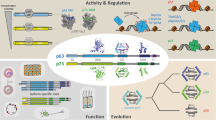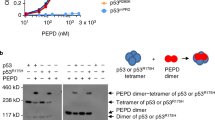Abstract
The p53 tumor suppressor gene, which is induced by DNA damage and/or stress stimuli, causes cells to undergo G1-arrest or apoptotic death; thus it plays an essential role in human carcinogenesis1,2. We have searched for p53-related genes by using degenerate PCR, and have identified two cDNA fragments similar to but distinct from p53: one previously reported, p73 (refs. 3,4), and the other new. We cloned two major splicing variants of the latter gene and named these p51A and p51B (a human homologue of rat Ket). The p51A gene encodes a 448-amino-acid protein with a molecular weight of 50.9 kDa; and p51B, a 641-amino-acid protein with a molecular weight of 71.9 kDa. In contrast with the ubiquitous expression of p53, expression of p5I mRNA was found in a limited number of tissues, including skeletal muscle, placenta, mammary gland, prostate, trachea, thymus, salivary gland, uterus, heart and lung. In p53-deficient cells, p51A induced growth-suppression and apoptosis, and up-regulated p21waf-1 through p53 regulatory elements. Mutations in p51 were found in some human epidermal tumors.
This is a preview of subscription content, access via your institution
Access options
Subscribe to this journal
Receive 12 print issues and online access
$209.00 per year
only $17.42 per issue
Buy this article
- Purchase on Springer Link
- Instant access to full article PDF
Prices may be subject to local taxes which are calculated during checkout
Similar content being viewed by others
References
Morgan, S.E. & Kastan, M.B. p53 and ATM: cell cycle, cell death, and cancer. Adv. Cancer Res. 71, 1–25 (1997).
Wang, X.W. & Harris, C.C. p53 tumor-suppressor gene: clues to molecular carcino-genesis. J. Cell. Physiol. 173, 247–255 (1997).
Kaghad, M. et al. Monoallelically expressed gene related to p53 at 1p36, a region frequently deleted in neuroblastoma and other human cancers. Cell 90, 809–819 (1997).
Jost, C.A., Marin, M.C. & Kaelin, W.G. Jr., p73 is a human p53-related protein that can induce apoptosis [see comments]. Nature 389, 191–194 (1997).
Hansen, R. & Oren, M. p53; from inductive signal to cellular effect. Curr. Opin. Gen. Develop. 7, 46–51 (1997).
Levine, A.J. p53, the cellular gatekeeper for growth and division. Cell 88, 323–331 (1997).
Sidle, A. et al. Activity of the retinoblastoma family proteins, pRB, p107, and p130, during cellular proliferation and differentiation. Crit. Rev. Biochem. Mol. Biol. 31, 237–271 (1996).
Oren, M. Lonely no more: p53 finds its kin in a tumor suppressor haven. Cell 90, 829–832 (1997).
Dickman, S. First p53 relative may be a new tumor suppressor [news]. Science 277, 1605–1606 (1997).
Schmale, H. & Bamberger, C. A novel protein with strong homology to the tumor suppressor p53. Oncogene 15, 1363–1367 (1997).
Xu, X. et al. A mouse erythroleukemia cell line possessing friend spleen focus-forming virus gp55 transgene and temperature-sensitive mutant p53 gene. Jpn. J. Cancer Res. 86, 284–291 (1995).
Pietenpol, J.A. et al. Sequence-specific transcriptional activation is essential for growth suppression by p53. Proceedings of the National Academy of Sciences of the United States of America91, 1998–2002 (1994).
El-Deiry, W.S. et al. WAF1, a potential mediator of p53 tumor suppression. Cell 75, 817–825 (1993).
Canman, C.E. & Kastan, M.B. Role of p53 in apoptosis. Adv. Pharmacol. 41, 429–460 (1997).
Jia, L.Q. et al. Screening the p53 status of human cell lines using a yeast functional assay. Mol. Carcinog. 19, 243–253 (1997).
Kern, S.E. et al. Oncogenic forms of p53 inhibit p53-regulated gene expression. Science 256, 827–830 (1992).
Chen, C. & Okayama, H. High-efficiency transformation of mammalian cells by plasmid DNA. Mol. Cell. Biol. 7, 2745–2752 (1987).
Newell, M.K., Haughn, L.J., Maroun, C.R. & Julius, M.H. Death of mature T cells by separate ligation of CD4 and the T-cell receptor for antigen. Nature 347, 286–289 (1990).
Frebourg, T. et al. A functional screen for germ line p53 mutations based on transcriptional activation. Cancer Res. 52, 6976–6978 (1992).
Takahashi, H. et al. Mutation, allelotying, and transciption analyses of p73 gene in prostatic carcinoma. Cancer Res. (in press).
Author information
Authors and Affiliations
Rights and permissions
About this article
Cite this article
Osada, M., Ohba, M., Kawahara, C. et al. Cloning and functional analysis of human p51, which structurally and functionally resembles p53. Nat Med 4, 839–843 (1998). https://doi.org/10.1038/nm0798-839
Received:
Accepted:
Issue Date:
DOI: https://doi.org/10.1038/nm0798-839
This article is cited by
-
The urothelial gene regulatory network: understanding biology to improve bladder cancer management
Oncogene (2024)
-
ΔNp63α transcriptionally represses p53 target genes involved in the radiation-induced DNA damage response
Radiation Oncology (2022)
-
Structural diversity of p63 and p73 isoforms
Cell Death & Differentiation (2022)
-
Tissue-specific expression of p73 and p63 isoforms in human tissues
Cell Death & Disease (2021)
-
ΔNp63 transcript loss in bladder cancer constitutes an independent molecular predictor of TaT1 patients post-treatment relapse and progression
Journal of Cancer Research and Clinical Oncology (2019)



